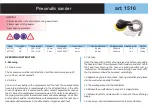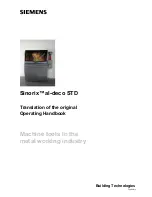
3
INSTRUCTIONS FOR SAFE HANDLING
1. Make sure that the tool is only connected to the
voltage marked on the name plate.
2. Never use the tool if its cover or any bolts are missing.
If the cover or bolts have been removed, replace
them prior to use. Maintain all parts in good working
order.
3. Always secure tools when working in elevated
positions.
4. Never touch the blade or other moving parts during
use.
5. Never start a tool when its rotating component is in
contact with the workpiece.
6. Never lay a tool down before its moving parts have
come to a complete stop.
7.
ACCESSORIES:
The use of accessories or
attachments other than those recommended in these
instructions might present a hazard.
8. REPLACEMENT PARTS: When servicing use only
identical replacement parts.
ASSEMBLY
FITTING THE SANDING PAPER (Fig. 1)
Fit the paper over the pad so that it covers the entire area.
Make sure the sanding paper (4) is even with the edges
and that the dust collection holes in the pad and sanding
paper is aligned and the sanding paper evenly overlaps the
pad. Never use your sander without a sanding paper.
USING THE VACUUM ADAPTER
(
Fig. 2
)
Your sander is equipped with a vacuum adapter (3), which
is designed for collect dust task. Insert the vacuum adapter
into the rear dust outlet of sander. Then pull the vacuum
adapter and make sure it is tightened securely on the dust
outlet.
Then connect the hose of a vacuum cleaner.
First please turn on the vacuum cleaner, then turn on the
sander. If you stop sanding,first turn off the sander, then
turn off your vacuum cleaner.
ATTACHING A SANDING SHEET
Connect the plug to the power supply. To start the machine,
squeeze the ON/OFF trigger switch; to stop the machine,
release the ON/OFF trigger switch.
WARNING!
Remove the plug from the socket before carrying out any
adjustment, servicing or maintenance.
WARNING!
Never use the sander unless the entire base is fitted with
sandpaper.
THE SANDER HAS A BASE WITH
1 . Select the required grade of sandpaper.
2. Align and stick the sandpaper onto the base of the tool.
OPERATION
SPECIFICATIONS
Voltage............................................................... 230V,50Hz
Input power..................................................................130W
No load speed.....................................................12000min
-1
Sanding paper size...................................140X140X100mm
Diameter of orbit......................................................Ø1.0mm
Net weight.................................................................. 0.93kg
SPECIFIC SAFETY RULES FOR MOUSE
SANDER
1. Make sure that the foreign objects such as nails and
screws have been removed from the work before
commencing sanding .
2. Rags, cloths cord, string and the like around the work
should never be left area.
3. Always switch off before the sander is put down.
4. Do not force the sander. Let the tool work at a
reasonable speed. Overloading will occur if too much
pressure is applied and the motor slows resulting in
inefficient sanding and may damage the sander motor.
5. When an extension cable is required, be sure that it
has the right rating for the tool and is in safe electrical
condition.
6. Fully unwind cable drum extension to avoid potential
overheating.
7. Do not touch the moving sanding belt.
8. Do not continue to use worn, torn or heavily clogged
sanding belts.
9. Always connect the dust bag or use dust extraction
system when sanding wood.
DESCRIPITION
1. ON/OFF switch
2. Base
3. Vacuum adapter
4. Sanding paper
5. Foam pad
6. Storage bag
STANDARD ACCESSORIES
1pc vacuum adapter, 6pcs sanding paper (80G/2pcs ,
120G/3pcs , 180G/1pc ), 2pcs foam pad (5mm /8mm), 1pc
storage bag
SWITCHING ON AND OFF
Connect the plug to the power supply. To start the machine,
press the ON/OFF switch at the end marked with " "; to
stop the machine, press the switch at the end marked " ".
Using the finishing sander.
WARNING!
The sander is designed for sanding wood, metal, plastic
and similar material. It can be used for sanding and
finishing the surfaces.
1 . Switch on the sander before you place it on the
workpiece and move it over the surface to be
smoothed in a circular motion.
Summary of Contents for MS-130
Page 1: ...MS 130...
Page 2: ...1 1 2 1 4 3 6 5 4 2...
Page 6: ...5 NOTE...
Page 7: ...6 NOTE...
Page 8: ......


























